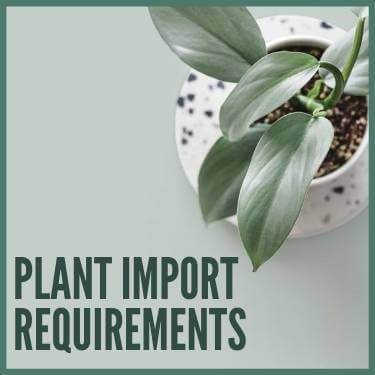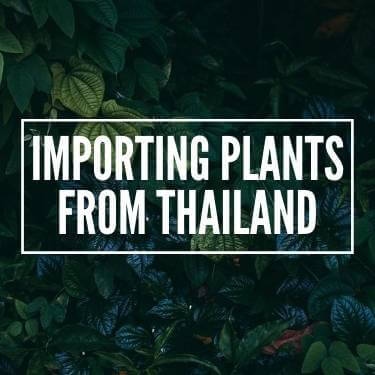
 Copy URL to Clipboard
Copy URL to Clipboard
If you’ve ever considered importing plants to the USA, then you’ve probably noticed that it’s not the simplest process you’ll ever take part in. Whether you’re doing so for personal reasons or for business ones, a little extra work needs to go into it than you might have initially thought. There are many different rules and regulations, and, for someone completely out of this circle, it can be somewhat awkward to deal with.
When importing plants to the U.S., you’ll need to comply with USDA requirements enforced through the Animal and Plant Health Inspecton Service (APHIS). This includes obtaining an import permit from the USDA and filing all necessary import paperwork. Endangered plants are also subject to additional regulations through the Convention on International Trade in Endangered Species (CITES) and the Endangered Species Act (ESA).
At USA Customs Clearance, powered by AFC International, we want to be able to help you with whatever questions you may have regarding importation. We’ll allow you to book a customs consulting session while offering a customs bond so that your shipment is covered financially.

Work with a specialist to make importing and exporting to the USA a hassle-free process.
Get the details you need with our import consulting services.

As previously mentioned, different requirements exist for different kinds of plants and the industries with which they operate under. Let us now run through some of the typical import requirements:
– If you are looking to import or export CITES or ESA plants and plant products, then USDA regulation 7 CFR 355 requires you to possess a valid USDA Protected Plant Permit. CITES-listed plants are required to enter the US through a designated port.
– The fee for the Protected Plant Permit is $70 and should be paid via check or money order made payable to Plant Protection and Quarantine.
– APHIS has a searchable, online, free-to-use database, known as the Fruits and Vegetables Import Requirements (FAVIR) database.
– It allows people to search for authorized fruits and vegetables and their requirements for importation into the US.
– Commodities approved under the Q56 revision will not be reflected in the Code of Federal Regulations, but rather in the FAVIR online database.
The requirements for safely importing hemp plants and hemp seeds differ slightly. There are also different requirements regarding whether they’re imported from Canada or not.
– Importing hemp seed from Canada:
– Importing hemp plants from Canada:
– Importing hemp seeds and plants from anywhere else:
– The Lacey Act combats trafficking in illegal wildlife and plants. It is unlawful to import certain plants and plant products without an import declaration.
– The official APHIS website will be able to provide you with a plethora of information regarding the requirements and regulations of plants and products covered by the Lacey Act.
Permits are required in order to import plants to USA. Plant and plant product permits include plants for planting such as nursery stock, fruits and vegetables, timber, cut flowers, and small lots of seed. There are many different kinds of permits, and the convoluted set may confuse some onlookers. Here are the currently available permit applications:
– PPQ 585: An application for a permit to import timber or timber products.
– PPQ 587: An application for a permit to import plants or plant products, including:
– PPQ 546: An application for propagative plants that require post entry quarantine
– PPQ 588: Controlled import permits to import plants or plant products for experimental, therapeutic or developmental purposes
– PPQ 621: An application for a protected plant permit to engage in the business of import, exporting, or re-exporting protected plants (CITES)
– PPQ 586: An application for a permit to transit plant products, plant pests, and soil through the US.

Work with a specialist to make importing and exporting to the USA a hassle-free process.
Get the details you need with our import consulting services.

In some cases, plants will need to be quarantined and treated accordingly. The USDA APHIS will determine the type of treatment necessary when a pest of quarantine significance is prevalent in the country. Treatments can be chemical and non-chemical.
Fresh fruits and vegetables that are admissible into the United States may require quarantine treatment prior to being allowed into the country. Irradiation treatments that have been developed recently are considered viable phytosanitary options for mitigating against certain quarantine significant pests.
The post-entry quarantine is in place to widen the range of plants and foreign sources where plants can be imported from. Through careful monitoring during quarantine, plants can be confirmed to be free of pests before entering the marke. The regulations are listed and specified in 7 CFR 319.37-23. The requirements for post-entry quarantine are located in the plants for planting manual.
You can’t have healthy plants without the right type of associated soil. There are a few key differences when it comes to importing soil. Read our guide on importing soil to the U.S. for more information.
There will be an array of fees that one has to pay in order to get this kind of transaction over the line. Inspection or handling fees, including customs duty, will be taken during a successful importation into the US. If you wish to learn about the kinds of fees you might need to pay during the process, our HTS Code Look-Up tool allows you to search an extensive database of product descriptions.
Ultimately, the duty will vary based on where the plant is coming from and what type of plant it is. In addition to duties collected on the import, a Merchandise Process Fee is also collected.
The responsibility of paying duties always falls on the importer of record. However, the importer of record will change depending on the Incoterms of the shipment. To learn more about Incoterms , take a look at our blog What Are Incoterms?

Thailand is home to some of the most beautiful and exotic plants this entire planet has to offer. This deep array of flora attracts people from all over the globe – and, more specifically, the USA, leading them to import. Here are just are a few that are on offer from Thailand:
Ratchaphruek: Also known as the chaiyapruek or the golden rain, the Ratchaphruek flower bursts into bloom at the end of the cooler seasons and is the national flower of Thailand. It’s a flower that can be seen in an array of different settings – you’ll see them in places like parks and roadsides, usually. Their pretty aesthetic, contrast with the summer sky, and tendency to fall from their trees make them a very popular flower to import.
Lotus: The lotus flower is popular all over the globe, so it’s no surprise that it gets imported into the United States on a regular basis. It’s a heavily religious symbol, too, as it is seen as the flower of Buddhism. While Buddhism may not be the leading religion in the United States, there is still a hefty number who practice it on this continent.
The contrasting colors make it a delight on the eyes, and its seeds are also an edible delicacy. The leaves can be used to wrap food, and the root can be turned into soup.
Orchid: There are more than one thousand species of orchid in Thailand – this glorious array gives those interested a lot to choose from, meaning the desire from them from all over the globe increases. Thailand has the most orchids of any country in Southeast Asia and is one of the world’s leading exporters of the planet, so any importer would know that they’d receive the right kind of service and a smooth transaction when working with this kind of process.
Jasmine: Jasmine is the symbol of Mother’s Day in Thailand. It has a wonderful smell to it and represents pure and unconditional love between a mother and her child. This kind of message and representation is more than enough to boost its popularity with those in the west. It is also used on desserts to add a lovely fragrance and is sometimes used to make tea. The flower may also be used to make perfumes and essential oils, which is another very popular activity among people all over the globe.
Bat Flower: The bat flower is a more polarising flower in that some enjoy the look of it, and others may not be so crazy about it. Named because of its resemblance to a bat, it’s also known as the ‘devil flower.’ It grows primarily in the jungles of Thailand and thrives in humid conditions. This unique and strange look makes individuals and groups alike wish to import to the USA.
Hibiscus: This flower is seen all around Thailand and comes in a variety of shapes and sizes. We can use it to make tea and is seen as a traditional herbal remedy in many areas of the world.
Such beauty regarding these Thai flowers leads nurseries in the US to decide that importing from Thailand is the right way to go.

Worried about the Strict Regulations? Ask Our Experts.
Our 30 Minute Licensed Expert Consulting Will Personally Guide You.
You’ll have many different methods of importing plants into the US – it’s just a case of picking the right method that suits the kind of item you’re bringing in. You can import via air, sea, truck, and rail. Let’s quickly go through the different options on offer:
Air: Air transport is obviously a very convenient way of shipping goods such as plants all over the world. The positives of air freighting are that you can pretty much guarantee safety and security due to the protocols and controls associated with each flight. It’s also the safest mode of transport in general, of course. You can also take into account the speed at which the goods will be delivered.
You have to think about cons such as the weight and size limits, however, as planes only allow a certain amount per party. The cost might be a little higher than you’d like, too.
Sea: Importing goods via sea or ocean is a helpful way of working as it can work at relatively cheaper than other options. You’re also able to carry lots of times – both heavy goods and smaller ones at a high volume. It’s an eco-friendly way of operating, too.
Some cons are that it’s a pretty slow method as water travel isn’t exactly light-speed. There can be delays, too, resulting in customers choosing another supplier if they’re unsatisfied with the time taken.
Road: When it comes to shipping domestically, you’ll know all about road courier services as you’ll have dealt with them before. Using for long-distance imports are a little different, though. The pros are that it’s a relatively low cost and that scheduled and next-day deliveries are a viable option. You can track the location, and it’s usually a secure and private process.
Some cons are that, of course, the longer-distance imports will take quite a long time. Traffic and breakdowns can also be an issue. There is a risk of the goods being damaged over time, too.
Rail: Importing via rail is a smooth option for an individual or group as it’s environmentally friendly and will get speedy transactions done through the likes of Mexico and Canada. It’s more expensive than, say, road courier services. You also have to deal with the fact the routes are not as flexible as you’d like, and that the final destination won’t be your final one – you’ll need further transportation.
If you’re on a tight deadline and need your products quickly, you’ll need to opt for international expedited shipping. While expedited shipping comes with a hefty cost, it’s a necessary evil when time is of the essence.

A customs broker’s (sometimes known as an import broker) job is to ensure the import and export of goods goes as planned. They’ll deal with the formalities and facilitate the clearance of goods through customs processes. Much like a broker in any other walk of life, they’ll represent a party and do what’s best for them. They’ll handle tasks such as paperwork, monitoring shipments, and coding goods.
As someone looking to import plants into the USA, you’ll need to make sure everything is in order so you do not have a flawed transaction. A customs broker will be able to take the stress and strain away from you while this process is ongoing and allow you to smoothly import what you desire. They’ll work directly with you and allow you to understand what is going on during every step. Due to their experience, they will be able to oversee pretty much everything and answer any query you might have along the way.
We know that this kind of process isn’t going to be the most straightforward thing you’ve ever done – especially if this is going to be your first time. Nobody likes heading into something without having the knowledge about what’s ahead, so that’s why we want to help you out. If you’re importing plants to USA – or looking to do anything regarding importing or exporting – then USA Customs Clearance is here to help.
We’ll help you with consultations whenever you need them. Whether it’s regarding imports or exports, we’ll have the knowledge to provide you with what you need. We’ve years of experience, so we know a thing or two about dealing with some of the most tedious of instances in terms of worldwide distribution.
When it comes to exporting goods from the US, we’re aware that dealing with movement to Canada or Mexico can carry a few more implications, so we offer specific consulting with regards to the two aforementioned territories as well as a general consulting service.
If your imports are related to commercial activities or are required to meet federal regulations, then you’ll need a customs bond in order to guarantee the payment of import duties and taxes. This is where we can also help as we’ll offer you an annual customs bond for $235*, allowing you to freely import plants to USA for the next twelve months – and to begin straight away!
Give us a call at (855) 912-0406 to get started!
 Copy URL to Clipboard
Copy URL to Clipboard
Hello,
I bought a nursery-grown agave from eBay (only one plant), and the seller will send the plant from South Africa with a phytosanitary certificate. Do I need to apply for any permits or other documentation?
Looking to import a Vietnamese Blue Bell Bonsai and other bonsai trees, do I need to have a specific permit fron the seller? They are private sellers.
Thank you.
Fred R
I’m living in CA. Can I buy some orchid on Ebay, but they ship from Thailand or Vietnam…to USA? Is there anything trouble.
hello! im planning to import plants (house plants for collection) to Chicago Illinois from indonesia/philippines. i read that if it is 12 or fewer plants, the phytosanitary permit is needed. do i still need a permit or any other documents in order to push through the importation?
do i have to do anything else other than informing the sender to comply the phyto certificate? thank you!
hello! im planning to import plants (house plants for collection) from indonesia/philippines. i read that if it is 12 or fewer plants, the phytosanitary permit is needed. do i still need a permit or any other documents in order to push through the importation?
do i have to do anything else other than informing the sender to comply the phyto certificate? thank you!
We wish to learn about import/export of dahlia tubers from individual growers (not commercial) to foster exchange of new varieties. Once I have the necessary authoritative information, it will be published in the American Dahlia Society Bulletin for better understanding of requirements and special conditions. Looking through the APHIS Manuals, I see little direct reference to dahlias. Pls advise.
If I’m getting 6 succulents shipped bare root from Thailand accompanied by a phytosanitary certificate, do I need to do anything else to make sure they arrive safely?
I would like to bring some agaves and cacti to plant in our yard. I live in El Paso so its a short trip to Juarez. May I bring up to 12 plants? Included would be 1 madagascar palm Pachypodium lamerei
Good morning! I have gymno cacctus house plant. I’am planning to bring them to US. Do I need permit?
Hi – I want to import some mulberry cuttings. I read that a permit is not needed when importing 12 or fewer plants. How does this apply to mulberry cuttings for propagation? I wanted to have 15 cuttings sent from a few cultivars. What rules apply? Am I exempt?
Hi Timothy,
Your situation will vary depending on whether these cuttings are for personal or commercial use. One of our customs experts will reach out to you shortly to obtain additional information so that we can assist you. We look forward to helping you!
Good day Custom Agent,
What is your total and complete cost, to complete the required documentation that is required in order to send plant-rhizomes from Canada to the U.S., on an order to order basis. I need certification to deliver rhizomes to customers in the U.S for regular, on -going, domestic, small order(s) basis.
Thank you, Eve
Hi Eve,
In order to provide you with an accurate quote, we need to obtain specific information from you including the tariff classification of your plant-rhizomes, their value, and more. One of our customs experts will reach out to you shortly to obtain the additional information that we need. We look forward to helping you!
I just have a basic question. I am importing plants from thailand. I live in Seattle. When plants come in do they go to a random port 9f entry or would they enter thru the customs nearest to me which would be Seattle. I’m just trying to understand the process. Thank you.
Hi Katherine,
There are multiple plant inspection stations located that are operated by the USDA and located throughout the U.S. There happens to be one in Seatac, Washington which is where your plants would go through if you import through Seattle.
I am planing to import mango plants from India I need to know if you can help me.
Hi Ravi,
We can definitely help you! One of our import experts will reach out to you shortly to obtain additional information so that we can assist you.